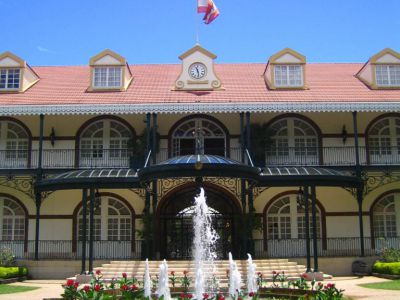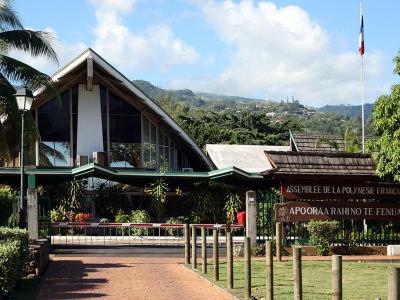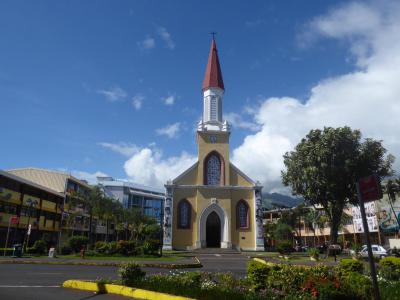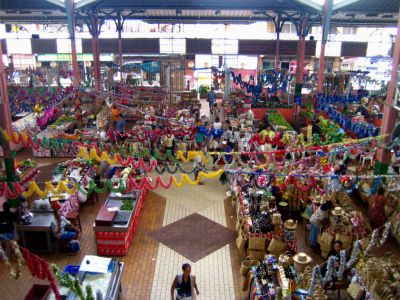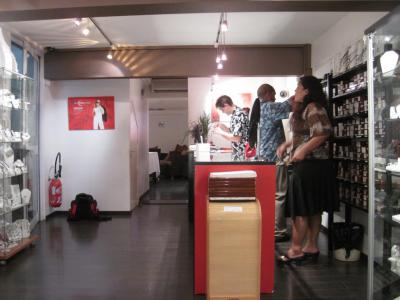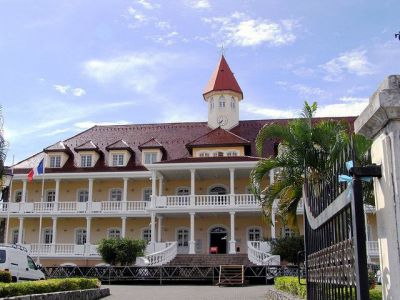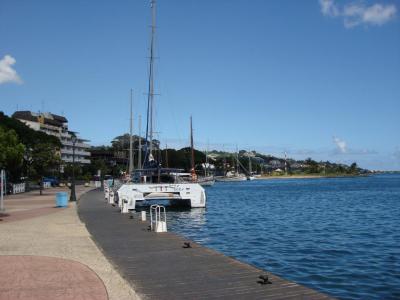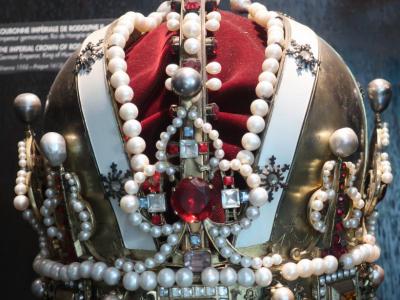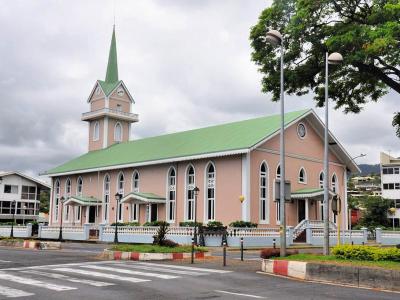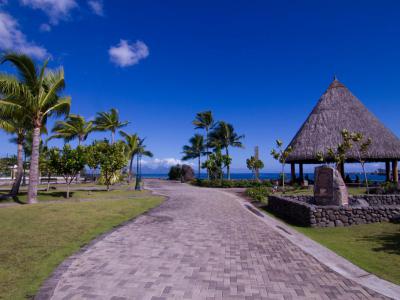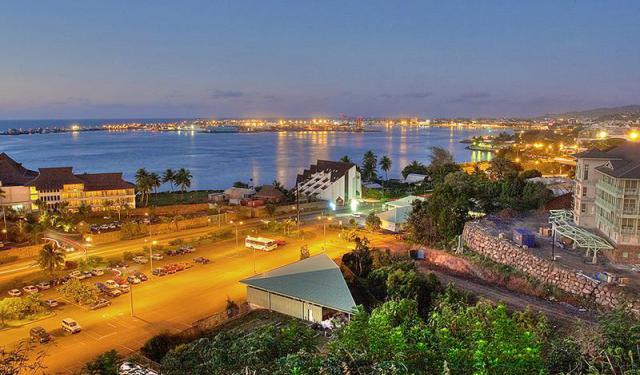
Papeete Introduction Walking Tour (Self Guided), Papeete
The islands of the Pacific were gradually settled by daring sea voyagers in large multiple hulled catamarans (canoes). Tonga and Samoa were reached by 1300 BC. By 500 BC, the Marquesas Islands were known to the navigators. Tahiti was settled between 300 and 800 AD.
Tahiti was divided into clan territories managed by chiefs and under-chiefs. Spanish explorers began arriving in the 16th century. The British opened relations in the late 18th century. A French expedition dropped anchor in 1768. The mutineers of the HMS Bounty became mercenaries in the service of chief Outu, later King Pomare I.
There followed an era of peace and growth under the Pomare dynasty. Tahiti became a French protectorate in 1842, and a colony of France in 1880, effectively ending the rule of the Pomares.
The name Papeete, or Pape'ete, as it is sometimes spelled, is a Tahitian expression literally meaning, "water from a basket." Papeete is the is the spiritual and cultural center and capital city of French Polynesia. It is located on the west coast of Tahiti. It is famous for its rare black pearls and pearl markets.
The Papeete Market is renowned for its exotic fruits and local foods like nono, breadfruit, carambolas, soursops and sweetsops. From the market walk to Parc Bouganville, sit under a banyan tree and have a picnic. The Papeete Town Hall is a majestic example of French colonial architecture.
See the shell-like Territorial Assembly next to the Presidential Palace, Notre Dame Cathedral of Papeete and the Protestant Church of Paofi, where the singing is angelic. Need a break? Stroll along the the picturesque waterfront promenade and connect with the squares of To'Ata Square and Vaiete Square and the vast, serene Paofi Gardens.
Papeete is the heart of Tahiti. It is a lively city. It has art, culture, restaurants, food trucks called roulottes, plentiful shopping, and miles of black sand beaches within easy reach. Come to swim, shop, worship, sing and dance in green, tropical Papeete.
Tahiti was divided into clan territories managed by chiefs and under-chiefs. Spanish explorers began arriving in the 16th century. The British opened relations in the late 18th century. A French expedition dropped anchor in 1768. The mutineers of the HMS Bounty became mercenaries in the service of chief Outu, later King Pomare I.
There followed an era of peace and growth under the Pomare dynasty. Tahiti became a French protectorate in 1842, and a colony of France in 1880, effectively ending the rule of the Pomares.
The name Papeete, or Pape'ete, as it is sometimes spelled, is a Tahitian expression literally meaning, "water from a basket." Papeete is the is the spiritual and cultural center and capital city of French Polynesia. It is located on the west coast of Tahiti. It is famous for its rare black pearls and pearl markets.
The Papeete Market is renowned for its exotic fruits and local foods like nono, breadfruit, carambolas, soursops and sweetsops. From the market walk to Parc Bouganville, sit under a banyan tree and have a picnic. The Papeete Town Hall is a majestic example of French colonial architecture.
See the shell-like Territorial Assembly next to the Presidential Palace, Notre Dame Cathedral of Papeete and the Protestant Church of Paofi, where the singing is angelic. Need a break? Stroll along the the picturesque waterfront promenade and connect with the squares of To'Ata Square and Vaiete Square and the vast, serene Paofi Gardens.
Papeete is the heart of Tahiti. It is a lively city. It has art, culture, restaurants, food trucks called roulottes, plentiful shopping, and miles of black sand beaches within easy reach. Come to swim, shop, worship, sing and dance in green, tropical Papeete.
How it works: Download the app "GPSmyCity: Walks in 1K+ Cities" from Apple App Store or Google Play Store to your mobile phone or tablet. The app turns your mobile device into a personal tour guide and its built-in GPS navigation functions guide you from one tour stop to next. The app works offline, so no data plan is needed when traveling abroad.
Papeete Introduction Walking Tour Map
Guide Name: Papeete Introduction Walking Tour
Guide Location: Tahiti » Papeete (See other walking tours in Papeete)
Guide Type: Self-guided Walking Tour (Sightseeing)
# of Attractions: 10
Tour Duration: 2 Hour(s)
Travel Distance: 3.0 Km or 1.9 Miles
Author: karenl
Sight(s) Featured in This Guide:
Guide Location: Tahiti » Papeete (See other walking tours in Papeete)
Guide Type: Self-guided Walking Tour (Sightseeing)
# of Attractions: 10
Tour Duration: 2 Hour(s)
Travel Distance: 3.0 Km or 1.9 Miles
Author: karenl
Sight(s) Featured in This Guide:
- Presidential Palace
- Territorial Assembly
- Notre Dame Cathedral
- Municipal Market
- Tahiti Pearl Market
- City Hall
- Waterfront
- Robert Wan Pearl Museum
- Protestant Church of Paofai
- Paofai Garden (Jardin de Paofai)
1) Presidential Palace
Mr. Gaston Flosse, re-elected President of French Polynesia in 1996, decided to build a house where the president could reside. By the year 2000, he had inaugurated his dream palace. It was a remake of the former Broche Barracks on the Avenue Bruat in Papeete.
The Barracks were part of a military installation built by the colonial administration in 1885, intended to provide military and administrative services and to be a center for the defense and protection of the civilian population. The area was named Broche in honor of the first head of the Pacific Batallion to serve in France in World War I.
The architect in charge of the project was Pierre Lacombe. His instructions were to preserve the aspect of colonial and military architecture of the 19th century but modernize the comfort.
Today's Palace is a two-story house with a veranda and galleries. Large, rounded arches line both levels. The roof has large dormers, each one centered above the arch below. The center dormer over the main entrance has a clock. The Palace has a garden with a fountain, flowers, and plants chosen to add an exotic touch to the architecture.
There is a car parking and access for disabled visitors. Special theme events and guided tours can be arranged. The Palace area is closed at night.
The Barracks were part of a military installation built by the colonial administration in 1885, intended to provide military and administrative services and to be a center for the defense and protection of the civilian population. The area was named Broche in honor of the first head of the Pacific Batallion to serve in France in World War I.
The architect in charge of the project was Pierre Lacombe. His instructions were to preserve the aspect of colonial and military architecture of the 19th century but modernize the comfort.
Today's Palace is a two-story house with a veranda and galleries. Large, rounded arches line both levels. The roof has large dormers, each one centered above the arch below. The center dormer over the main entrance has a clock. The Palace has a garden with a fountain, flowers, and plants chosen to add an exotic touch to the architecture.
There is a car parking and access for disabled visitors. Special theme events and guided tours can be arranged. The Palace area is closed at night.
2) Territorial Assembly
The Territorial Assembly was built in 1960 on the site of Queen Pomare IV of Tahiti's residence. The former building suffered damages caused by termites. The Territorial Assembly is located within walking distance of the major attractions in Papeete; it is a 15-minute walk from Papeete port via Boulevard de la Reine Pomare IV.
The modern building of the Territorial Assembly is memorable for its shell-like roof and the statue of Pouvanaa a Oopa, a French Polynesian nationalist, politician, and advocate for French Polynesian independence. The Territorial Assembly Hall is the most important part of the government complex. The complex includes the High Commissioner's Residence and a clubhouse once patronized by French artist Paul Gauguin.
The Assembly building shares the compound manicured gardens and memorial statues with the Presidential Palace and French Polynesian Assembly on Tarahoi Square.
The modern building of the Territorial Assembly is memorable for its shell-like roof and the statue of Pouvanaa a Oopa, a French Polynesian nationalist, politician, and advocate for French Polynesian independence. The Territorial Assembly Hall is the most important part of the government complex. The complex includes the High Commissioner's Residence and a clubhouse once patronized by French artist Paul Gauguin.
The Assembly building shares the compound manicured gardens and memorial statues with the Presidential Palace and French Polynesian Assembly on Tarahoi Square.
3) Notre Dame Cathedral (must see)
Early in the 19th century, France enlarged its colonial presence in the Pacific. Tahiti was declared a protectorate of France in 1842. French missionaries began arriving almost immediately. Construction soon began on the Cathedral of Our Lady of the Immaculate Conception of Papeete on Général de Gaulle Street.
The Cathedral opened in 1875. It is the oldest Catholic church in Tahiti and one of the last standing structures of early colonialism. It was named after its illustrious antecedent, the Notre Dame of Paris. It sits on the waterfront, facing distant Mount Aorai.
The facade of the Cathedral is painted yellow and has two pilasters, one at each end of the front. There are three pointed arch-stained glass windows. The center window is the largest, directly above the recessed arched entrance portal. Above the center window is a clock. The hexagonal bell tower is topped with a pointed red spire.
The interior of the Cathedral holds both European and Polynesian design elements. An example is the full-size carved Madonna and Child. The Child brandishes breadfruit. The Cathedral is also known for its artistic representations of the Stations of the Cross. The stations incorporate both Tahitian and Roman cultures in the style of dress. The artistic style of the paintings was influenced by Paul Gauguin.
The Cathedral opened in 1875. It is the oldest Catholic church in Tahiti and one of the last standing structures of early colonialism. It was named after its illustrious antecedent, the Notre Dame of Paris. It sits on the waterfront, facing distant Mount Aorai.
The facade of the Cathedral is painted yellow and has two pilasters, one at each end of the front. There are three pointed arch-stained glass windows. The center window is the largest, directly above the recessed arched entrance portal. Above the center window is a clock. The hexagonal bell tower is topped with a pointed red spire.
The interior of the Cathedral holds both European and Polynesian design elements. An example is the full-size carved Madonna and Child. The Child brandishes breadfruit. The Cathedral is also known for its artistic representations of the Stations of the Cross. The stations incorporate both Tahitian and Roman cultures in the style of dress. The artistic style of the paintings was influenced by Paul Gauguin.
4) Municipal Market (must see)
In the heart of Papeete is located the city's Municipal Market. The commercial center has occupied the same location since 1869 and is a must-see for every visitor. The name of the Market, "Mapuru a Paraita" is emblazoned at the entrance of the large, renovated hall. The hall covers more than 7,000 square meters of floor space on two levels. It stands just a coconut throw from the seafront.
This large and crowded market hall offers local farm products, fish and meat, handicrafts, and souvenirs. On the ground floor, colorful stalls offer breadfruit, yams, taro, guavas, mangoes, soursops, and sweetsops. Follow the mishmash of aromas to the realm of fresh fish. The sea product department offers up tuna, bonito, mahi-mahi, parrot fish, mullet, and many other kinds of seafood.
Beyond the kingdom of the sea portion of the Market is Meatworld, a land of suckling pigs ruled over by Tahiti's irreplaceable meat producers. Beyond the land of meat are grandmothers creating garlands and leis from the flowers of Tahiti: tiara, tipanier, jasmine, and taina. There is a section for arts and crafts at the Market.
The artistry and craftsmanship of Polynesia surround the visitors. There are woven hats, necklaces, and carved sculptures from the Austral Islands and the Marquesas. There are also baskets of patchwork quilts inspired by Matisse and Gauguin art. Travelers will also find retailers selling Tahitian pearls. Pearl culture is monitored in French Polynesia, so buyers can purchase with confidence.
On the upper floor, the visitors will find the Manava Cafe with a wide selection of meals, coffees, smoothies, juices, and soft drinks. Both English and French languages are spoken at the Market. It may be useful to know basic numbers in French. For example, "cents" is "hundreds" and "milles" is "thousands."
On Mondays, the Market opens at 5 am and closes at 6 pm. On Sundays, the hours are from 3 am to 9 am.
This large and crowded market hall offers local farm products, fish and meat, handicrafts, and souvenirs. On the ground floor, colorful stalls offer breadfruit, yams, taro, guavas, mangoes, soursops, and sweetsops. Follow the mishmash of aromas to the realm of fresh fish. The sea product department offers up tuna, bonito, mahi-mahi, parrot fish, mullet, and many other kinds of seafood.
Beyond the kingdom of the sea portion of the Market is Meatworld, a land of suckling pigs ruled over by Tahiti's irreplaceable meat producers. Beyond the land of meat are grandmothers creating garlands and leis from the flowers of Tahiti: tiara, tipanier, jasmine, and taina. There is a section for arts and crafts at the Market.
The artistry and craftsmanship of Polynesia surround the visitors. There are woven hats, necklaces, and carved sculptures from the Austral Islands and the Marquesas. There are also baskets of patchwork quilts inspired by Matisse and Gauguin art. Travelers will also find retailers selling Tahitian pearls. Pearl culture is monitored in French Polynesia, so buyers can purchase with confidence.
On the upper floor, the visitors will find the Manava Cafe with a wide selection of meals, coffees, smoothies, juices, and soft drinks. Both English and French languages are spoken at the Market. It may be useful to know basic numbers in French. For example, "cents" is "hundreds" and "milles" is "thousands."
On Mondays, the Market opens at 5 am and closes at 6 pm. On Sundays, the hours are from 3 am to 9 am.
5) Tahiti Pearl Market
The Tahiti Pearl Market is just outside the Municipal Market Hall in Papeete, situated at 23 Colette Street. The lower level is more like a gallery than a shop. On the upper floor is where the real shopping experience is. Market guides escort visitors to the upper floor to show them around and to show the variety, quality, color, luster, and shape of available pearls.
What makes any type of pearl unique? The range of prices and the experience is thorough. When the combination of pearl factors is decided upon, the guide picks out a likely container and dumps its content on a tabletop. Shopper and guide sort through the pile and select the desired pearls. The selected pearls are drilled and set on site.
The vendor may be expected to provide information on the pearls to be selected. Information should include where the pearls were cultured. Pearl culture is carefully monitored in Polynesia. The size, shape, and grade of pearls are to be mentioned on the authenticity certificate.
What makes any type of pearl unique? The range of prices and the experience is thorough. When the combination of pearl factors is decided upon, the guide picks out a likely container and dumps its content on a tabletop. Shopper and guide sort through the pile and select the desired pearls. The selected pearls are drilled and set on site.
The vendor may be expected to provide information on the pearls to be selected. Information should include where the pearls were cultured. Pearl culture is carefully monitored in Polynesia. The size, shape, and grade of pearls are to be mentioned on the authenticity certificate.
6) City Hall
The City Hall, also known as Hotel de Ville or Mairie, is a faithful replica of the Mansion of Queen Pomare IV. Queen Pomare ruled Tahiti in 1845 when the island became a French Protectorate. The City Hall holds the office of the Mayor of Papeete. It is open to the public during regular hours and during the Gallery exhibition hours on the third floor.
The City Hall building is painted in buttercup yellow. It has wide, wrap-around galleries with cream-colored balustrades and columns on two floors. A grand staircase leads to the main entrance. The roof has dormers and a hexagonal tower with pointed arch windows and a pointed red spire. The overall architectural style is Neoclassic.
Inside the City Hall, beside the offices, there is a wedding chapel. The lobby is decorated with painted murals of island life. The artwork is strongly reminiscent of Gauguin. The Hall is located on Paul Gauguin Street and Colette Street in Papeete.
The City Hall building is painted in buttercup yellow. It has wide, wrap-around galleries with cream-colored balustrades and columns on two floors. A grand staircase leads to the main entrance. The roof has dormers and a hexagonal tower with pointed arch windows and a pointed red spire. The overall architectural style is Neoclassic.
Inside the City Hall, beside the offices, there is a wedding chapel. The lobby is decorated with painted murals of island life. The artwork is strongly reminiscent of Gauguin. The Hall is located on Paul Gauguin Street and Colette Street in Papeete.
7) Waterfront
Officially, the Waterfront of Papeete extends from To'Ata Square to Vaiete Square. The To'Ata Square features a pleasant waterfront stroll and sights of outrigger canoes training for races. The square also has "Tikis" religious monuments and statues intended to protect the sacred places of the islands.
On the western edge of the square is a 5,000-seat pavilion. There is the venue for the Heiva Festival, a month-long colorful celebration that commemorates the identity of the Francopolynesians, and rock concerts during the year. Minibars on-site offer light snacks and drinks in the evenings.
During the day, Vaiete Square is a pleasant resting place for cool breezes. A "Fare pote'e" house for exhibitions shows the work of local craftspersons. As the sun sets, everything changes. Food trucks, called "roulottes" open up, offering a variety of international treats. There are live performances and open-air tables by the sea.
On the western edge of the square is a 5,000-seat pavilion. There is the venue for the Heiva Festival, a month-long colorful celebration that commemorates the identity of the Francopolynesians, and rock concerts during the year. Minibars on-site offer light snacks and drinks in the evenings.
During the day, Vaiete Square is a pleasant resting place for cool breezes. A "Fare pote'e" house for exhibitions shows the work of local craftspersons. As the sun sets, everything changes. Food trucks, called "roulottes" open up, offering a variety of international treats. There are live performances and open-air tables by the sea.
8) Robert Wan Pearl Museum (must see)
The Robert Wan Pearl Museum is only for pearls. The Museum is located at BP850 Pomare Boulevard, facing Paofai Gardens in Papeete. The exhibits of the Museum show the history of pearls worldwide, the legends, and the technology of pearl culture. Robert Wan's collection holds the largest Tahitian pearl in existence.
The largest pearl goes by the name of Robert Wan. The collection also features a generous number of "black" pearls, a Tahitian specialty. Black Butterfly shells are found in the reefs around French Polynesia, especially in the archipelago of Tahiti. Over 95% of the world's black pearls are grown here.
The best quality pearl is made of thousands of microscopic layers of aragonite crystals. The play of light reflected by the crystals is called the "orient" or "iridescence." The black pearl actually may appear in a variety of colors. They come in the shape of spheres, buttons, pearls, teardrops, and generally asymmetrical forms.
Pearls are graded A, AA, or AAA. The museum pearls are AA-AAA. Pearls in Tahiti are cultured. The marketing of natural pearls is banned. The Museum is closed on Sundays and holidays.
The largest pearl goes by the name of Robert Wan. The collection also features a generous number of "black" pearls, a Tahitian specialty. Black Butterfly shells are found in the reefs around French Polynesia, especially in the archipelago of Tahiti. Over 95% of the world's black pearls are grown here.
The best quality pearl is made of thousands of microscopic layers of aragonite crystals. The play of light reflected by the crystals is called the "orient" or "iridescence." The black pearl actually may appear in a variety of colors. They come in the shape of spheres, buttons, pearls, teardrops, and generally asymmetrical forms.
Pearls are graded A, AA, or AAA. The museum pearls are AA-AAA. Pearls in Tahiti are cultured. The marketing of natural pearls is banned. The Museum is closed on Sundays and holidays.
9) Protestant Church of Paofai
Paofai Protestant Church is considered the center of the Evangelical Church of French Polynesia. It is located across from the Paofi Gardens of Papeete, near the seafront, slightly off the main road. The Church has peach-colored walls and a pale green roof with white inlays.
The windows of the building are plain high pointed arches. The tower has a larger window, a high-pointed spire, and a clock. The Church was built in 1818. The French name for the Church is "Eglise Evangelique" (Evangelical Church). The interior has a nave, two aisles, and a wrap-around balcony. The roof is supported by hand-painted large columns.
The pink-spired temple is a colorful sight during Sunday morning services. The local devotees dressed in white shirts and dresses sing enthusiastically without accompaniment. The effect has been described as angelic.
The windows of the building are plain high pointed arches. The tower has a larger window, a high-pointed spire, and a clock. The Church was built in 1818. The French name for the Church is "Eglise Evangelique" (Evangelical Church). The interior has a nave, two aisles, and a wrap-around balcony. The roof is supported by hand-painted large columns.
The pink-spired temple is a colorful sight during Sunday morning services. The local devotees dressed in white shirts and dresses sing enthusiastically without accompaniment. The effect has been described as angelic.
10) Paofai Garden (Jardin de Paofai) (must see)
The Paofai Gardens is a park in the picturesque center of Papeete, Tahiti. It covers 11.37 landscaped acres and a recreational area. The Paofai Gardens is a calm place with lush green trees: royal palms, coconut trees, and other flowering species. There are footpaths, trails, greens, and fountains. There are also restroom facilities and locker rooms.
The gardens touch on the Waterfront Esplanade that stretches from To'Ato Square to Vaiete Square. This stretch is an ideal stroll at sunset with the serene parklands on one side and sweeping views of the tropic sea on the other. Snack kiosks and cafes give the park a kind of tropical Parisian vibe.
Paved paths for walking are accessible to wheelchairs and prams. The park is reputed to be one of the best places in Papeete. There is no admission charge. The park is within a short distance of the cruise ship port and other attractions, like the Maison de la Culture (House of Culture) and the Monument aux Morts (Memorial).
The best times for a stroll would be early mornings and evenings. The days are often hot. In the evenings, the atmosphere grows a little festive with the arrival of food-bearing "roulettes" and live music.
The gardens touch on the Waterfront Esplanade that stretches from To'Ato Square to Vaiete Square. This stretch is an ideal stroll at sunset with the serene parklands on one side and sweeping views of the tropic sea on the other. Snack kiosks and cafes give the park a kind of tropical Parisian vibe.
Paved paths for walking are accessible to wheelchairs and prams. The park is reputed to be one of the best places in Papeete. There is no admission charge. The park is within a short distance of the cruise ship port and other attractions, like the Maison de la Culture (House of Culture) and the Monument aux Morts (Memorial).
The best times for a stroll would be early mornings and evenings. The days are often hot. In the evenings, the atmosphere grows a little festive with the arrival of food-bearing "roulettes" and live music.
Walking Tours in Papeete, Tahiti
Create Your Own Walk in Papeete
Creating your own self-guided walk in Papeete is easy and fun. Choose the city attractions that you want to see and a walk route map will be created just for you. You can even set your hotel as the start point of the walk.
Papeete Waterfront Walk
Papeete, the capital of French Polynesia, is renowned for its beautiful natural setting. Still, other than lush green areas and stunning beaches, the city boasts a number of man-made sights well worth checking out. Papeete's Waterfront is a vibrant area bustling with activity and attractions that capture the essence of the island's culture and beauty.
Start your waterfront tour at... view more
Tour Duration: 1 Hour(s)
Travel Distance: 1.6 Km or 1 Miles
Start your waterfront tour at... view more
Tour Duration: 1 Hour(s)
Travel Distance: 1.6 Km or 1 Miles
The Most Popular Cities
/ view all
